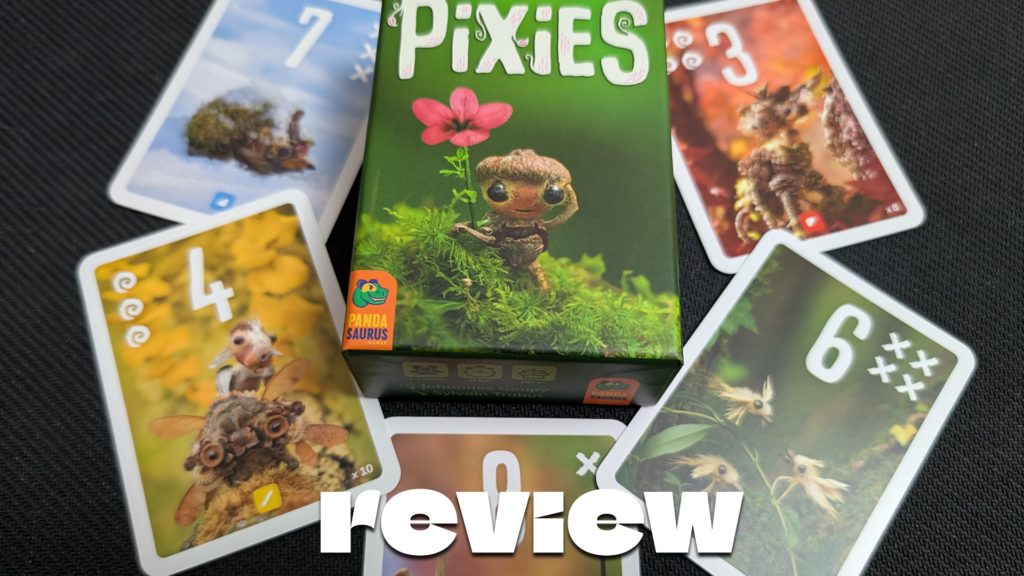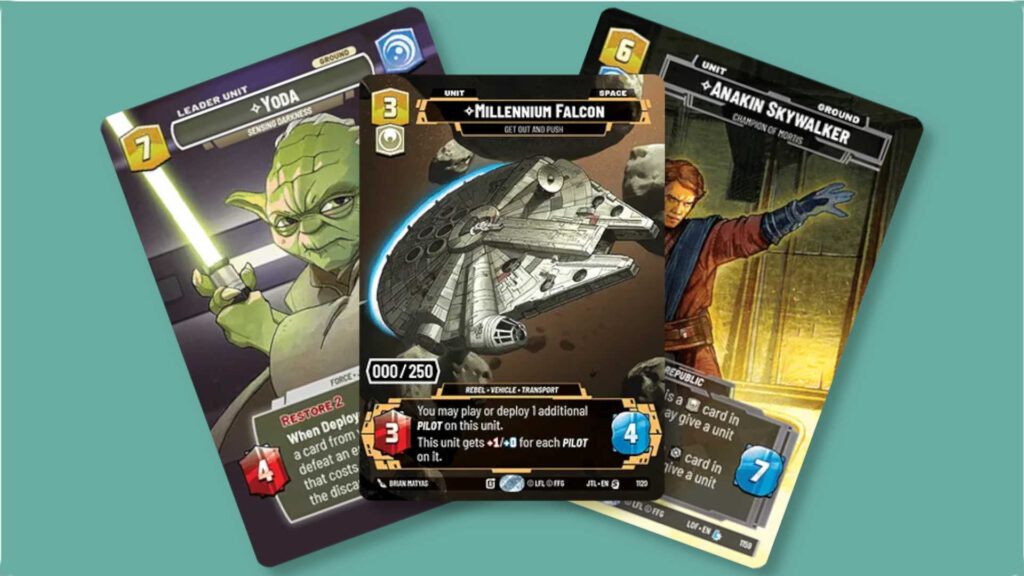Table of Contents
ToggleWhat Is Pixies?
Pixies, from Pandasaurus Games, may be the cutest card game you’ll play this year. In this game, you’ll draft cards to put in your play area, and use the symbols, colors, and numbers on the cards to try to score more points than your opponents. All the while, you’ll be creating a tableau of art filled with sculptures of adorable tiny creatures set across all four seasons. The game plays two to five players, ages eight and up, and takes about 30 minutes.
Pixies consists of 70 playing cards. Each card in the deck will have three different qualifiers:
- a number (one through nine)
- a color (in addition to the color of the art, this is denoted in a box at the bottom center of the card. Each color identifier box also has a ColorADD symbol to help people with colorblindness play the game)
- spirals on the left side or exes on the right of the number (some cards will have neither)
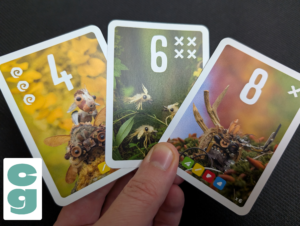
How Do You Play Pixies?
Pixies is played over three rounds. At the beginning of each round you’ll shuffle the deck of 70 cards and place it facedown. Then flip over one card for each player (in a two-player game, you’ll flip two cards for each player). Then in turn order, players will take one card from the faceup cards available and put it into their play area. (In a four-player game, the first player will have four options to take from, then the next player will only have three options, and so on, with the last player having to take the only card left.)
There are three possible ways to play the card you take:
- If you don’t have a faceup card with this number, put it in your play area faceup in that number’s spot (the game rules show a grid of three by three for a play area, but you could conceivably do a single row of nine, or whatever pattern you prefer).
- If you already have a faceup card with this number that doesn’t have a card underneath it, you choose which of the two cards of that number to keep faceup and put the other facedown underneath. The faceup card is now considered “validated,” which we’ll discuss more when we talk about scoring.
- If you already have a validated card of this number, you have to put the new card facedown in any empty spot. (This is most likely to happen when you’re the last player in a turn and there is only one card available to take, or near the end of a round when your play area is nearly full.)
After each player has taken their card (or two cards in a two-player game), you then check to see if any player has a card in all nine spots. If no one does, you’ll once again flip cards from the top of the deck for each player and continue playing. The player who took the last card in the previous turn becomes the first player in this turn. If, however, any player has all nine card slots filled, regardless of how many cards are faceup or down, the round immediately ends and you proceed to scoring. The game ends at the end of the third round.
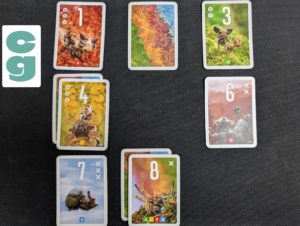
How Do You Score Points in Pixies?
At the end of a round, each player scores points based on three parameters: validated card numbers, spiral and x symbols, and color zones.
Scoring Validated Cards
A card is validated if you have a facedown card beneath it. You score points equal to the number on each validated card in your play area. So if at the end of a round your 1, 3, 7, and 8 spots all have faceup cards with facedown cards beneath them (i.e., validated), you’ll score points equal to the total of 1+3+7+8 =19.
Scoring Symbols
Each card may have either spiral symbols or exes (some cards have neither). The number of the symbols on the cards varies from card to card, and they’re not relative to the number of the card. Spirals are considered positive, and exes are negative. So at the end of a round if you have 12 spirals and 9 exes showing on your faceup cards (whether a card is validated or not doesn’t matter for this part of scoring), then your total symbol score is 12-9=3. There are also eight special cards in the deck that count as a spiral for each card of that color that you have faceup in your play area. So, for instance, if you have one of these special cards for yellow, and you have five faceup yellow cards, this card would count as five spirals for your symbol score. Also, there are several cards in the deck which have all four colors. These will be added when scoring special cards, and also count for scoring color zones (see below).
Scoring Color Zones
A color zone is made up of at least two cards of the same color touching along a side (i.e., orthogonally), but not diagonally. Each card that is part of your largest zone will score two points in the first round, three points in the second, and four points in the third. For scoring color zones, all faceup cards are counted, not just validated cards.
Here’s a play area example. Let’s look at how to score it.
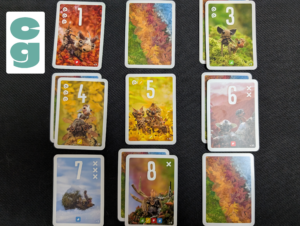
The 3, 4, 6, and 8 cards are all validated, giving us 3+4+6+8=21 points.
We have 11 spirals (seen on 1, 3, 4, and the 5, which is a special card which counts the yellow cards 4, 8, and itself for 3 spirals) minus 6 exes (on the 6, 7, and 8 spots) for 5 points.
Our largest color zone is yellow (4, 5, and 8), which is three cards. In the first round this would score us 2×3=6 points. This gives us a total of 21+5+6=32 points for the first round.
When you’re done with scoring, if you just finished the third round, the game ends and the player with the highest score total from the three rounds is the winner. If you just finished your first or second round, then you’ll gather all the cards, shuffle them up, and get ready to start the next round. The last player to play in the previous round starts the new round.
Is Pixies Fun to Play?
This game is a blast. It’s not terribly complicated, though it may take you a round or two to fully understand all the intricacies. And that’s one aspect where the game is very rewarding. It definitely falls under the category of “easy to play, harder to master.” There is a lot of strategy involved, especially as it takes some consideration to decide which path you’re planning to take with the cards that have been dealt. You can also go one step further with your game strategy and “hate-draft,” which means taking a card that doesn’t necessarily help you, but would give another player too much of an advantage. Doing this causes interactions with other players to get kicked up a notch. And if you’re competitive-minded like I am, then that’s exactly what you’re looking for.
Also, the art direction for the game is stellar. Each card features beautiful, and adorable, sculptures from the mind of Sylvain Trabut. So if the gameplay of Pixies doesn’t draw you in, the fantastic art certainly will.
The Card Gamer Verdict on Pixies
Looking for more fun and light card games to play with your friends and family? Then check out our reviews for Flip 7 and Gloom.

